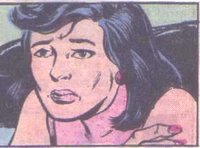 Jean LoringFirst appeared in:
Jean LoringFirst appeared in: Showcase #34, 1961
Current status: in 2017, it written in a Justice League volume that she was married to the
Silver Age Atom, Ray Palmer again.
Was subjected to the following acts of discrimination: in The Atom and Hawkman #45, Oct-Nov 1969, the last issue of the Silver Age Atom series, she was brainwashed/tortured into insanity by a subatomic race called the Jimberen, who thought her to be a descendant of an old queen of theirs, after they used a radiation-based device with which to brainwash her (see
this page from Darkmark's Comics Indexing Domain for details). She was fully cured of these effects in Justice League of America #81, June 1970, with Hawkman’s help there too, when he took her to Thanagar for treatment to cure her. She later fell prey to a similar situation in Super-Team Family #11, June-July 1977, when there too, she was brainwashed by more alien menaces. In 2004, after an absence of 4-5 years, she was turned into a plot device, just like Sue Dibny, in Identity Crisis: she was first implausibly depicted as the culprit in the murder of Sue in issue #7, and, at the same time, without any clear explanation, she was “revealed” to be crazy. Jean was also forced by the book’s writer into a stereotypical situation when she invites Ray Palmer, her ex-husband, to hit her(!), was then implausibly incarcerated in Arkham Asylum, and a tabloid newspaper headline is later shown saying that she was sexually assaulted in prison. Then, in what must be something like just a few hours in comic book time, was possessed by the Eclipso diamond in the Day of Vengeance miniseries (
Columbus Alive reported that the dialect sounded like a woman being sexually harrassed), and turned into an evil entity, later knocked comatose and left rotating in orbit (or something like that). It was later discovered in
Infinite Crisis that the Psycho Pirate had what to do with turning her into a new Eclipso. Worse, this whole "Jeanclipso" went on for quite a while, having taken place in the 52 weekly series and even in the #16th issue of the new Blue Beetle. In Countdown to Final Crisis #17 (note that the numbering for this goes backwards), after a clash with Mary Marvel, she was broken free of the diamond and fell to earth. Her current status is unknown.
What’s wrong with how this was done? I don’t know about what Jean went through in the Silver/Bronze Age, what with her being brainwashed into insanity and all that, but what she went through in Identity Crisis, including the near-lynching by a hanging-noose, was the lowest, most obscene of misogynistic stereotypes, providing a picture perfect example of why women end up shunning comic books. The same goes for the demonization she underwent in Day of Vengeance. And it doesn't matter if she's being controlled by the Eclipso diamond, what's being done is really sick.
To make matters worse, not only did the miniseries not give any mention of what past storylines Jean had been through, but much of the press coverage of Identity Crisis did not give any clear indication that she’d been a victim of science-fiction brainwashing years before either. In the case of Wizard magazine, they seemed to be trying to perpetuate a lie that she’d suffered numerous mental/nervous breakdowns* years ago, when that was not the case, and even if it was, she’d only been through such circumstances twice. (Wizard wrote a very ambiguous note that she “had a history” of nervous/mental breakdowns, yet made no more attempt to clear things up than the miniseries itself did.) On Newsarama, there was
another vicious lie written that she’d been repeatedly played as a villainess in past years. It’s a filthy lie mainly due to the fact that it didn’t even make it clear in just what way she was played as a villainess.
Why they’d want to go along with that crap is beyond me. But it shows that the media’s loyalties lie with the publishers, not with the audience or the character creators. Gardner Fox could be spinning in his grave.
The most devastating thing about this is the obvious contempt for the Atom, implying that the knee-jerkers who supported this demonization of Jean
and the Atom don’t have any love for the characters. There was an assumption 3 years ago that the Mighty Mite was going to get a return to the spotlight in a new series or miniseries, and maybe even be reunited with Jean, which would’ve been a very inspiring move, but the discrimination against them in Identity Crisis seems to imply otherwise. And the most scary thing about the part where Jean is forced into the stereotypical scene of inviting Ray to hit her is that it seems almost as if the writer was subtly insulting Janet Van Dyne, the Winsome, Wonderous Wasp, who'd been struck by her own husband, Hank Pym/Yellowjacket in
The Avengers in 1981. It's like a distorted reflection of what had happened in Marvel Comics back in the Bronze Age. And whether or not Jean may have been a pawn of any villains, that just doesn't counteract the bad taste left behind by the tasteless "event" books that exploited her so badly.
* On WIR, the term “nervous breakdown” is shown in between quotation marks, which seems to indicate that Gail also knew that this wasn’t so, and also may suggest that the falsehood of mental breakdowns may have been contrived several years ago too, I don’t know.
Labels: dc characters
 Vesper Fairchild
Vesper Fairchild








